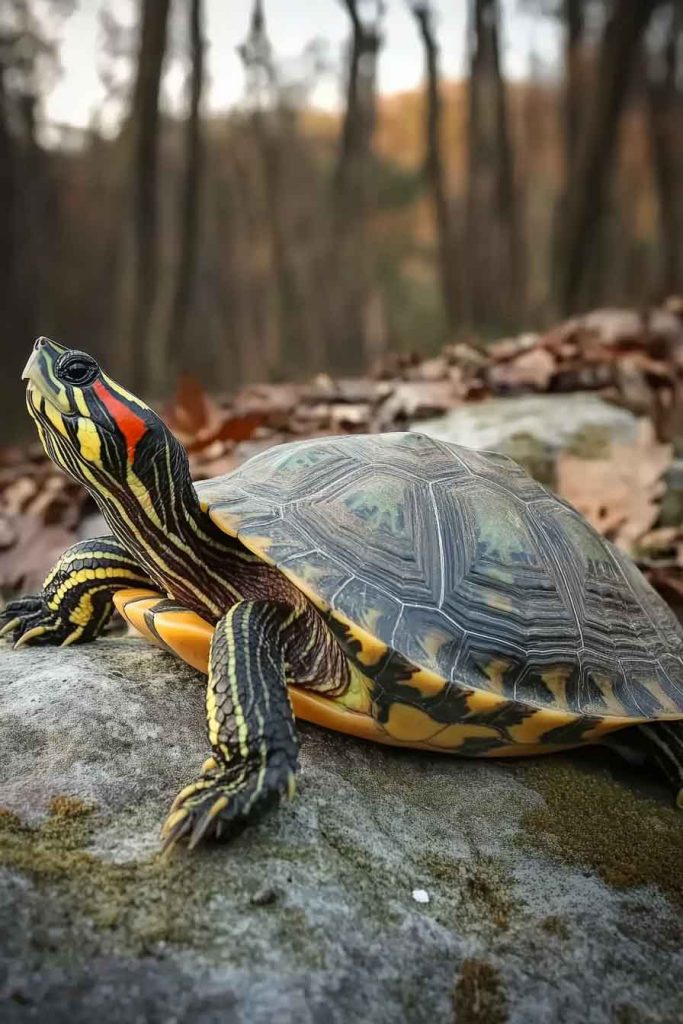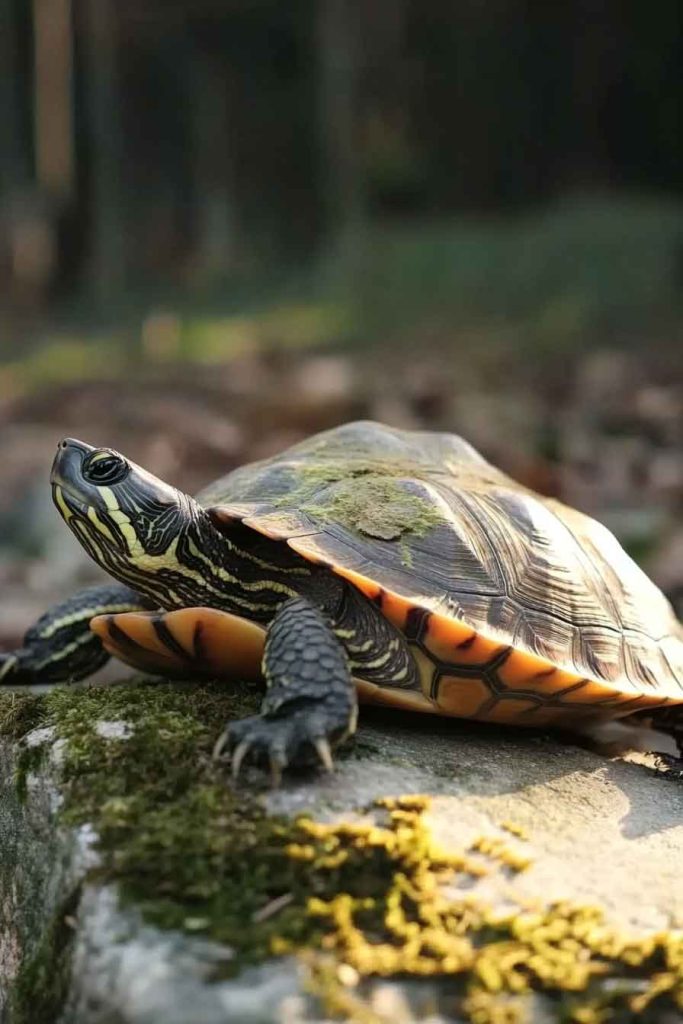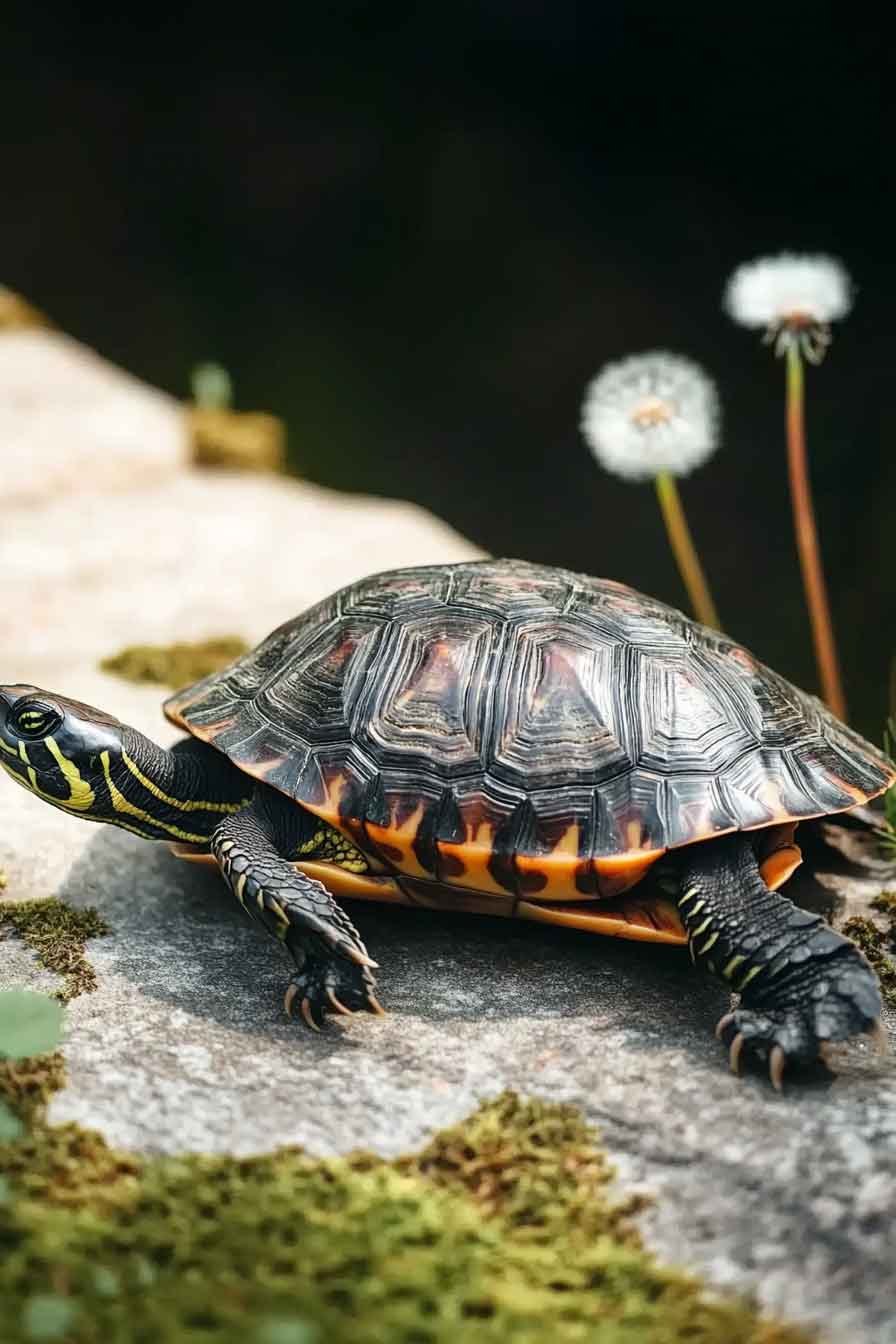Turtle Shell Peeling Explained: Is It Normal or a Sign of Trouble?
Have you seen your turtle’s shell peeling lately? I know it can be scary when you first notice it. You might think something is wrong with your pet turtle. But don’t worry! I’m here to help you understand everything about turtle shell peeling. Are Turtle Shells Supposed To Peel? Yes! Turtle shells are supposed to…
Have you seen your turtle’s shell peeling lately? I know it can be scary when you first notice it. You might think something is wrong with your pet turtle. But don’t worry! I’m here to help you understand everything about turtle shell peeling.
Are Turtle Shells Supposed To Peel?
Yes! Turtle shells are supposed to peel. It’s a normal thing that happens as your turtle grows up. When your baby turtle gets bigger and becomes an adult, the shell grows with them. The old outer layer needs to come off so the new, bigger shell can show. I call this healthy peeling.
Think of it like when you grow out of your old clothes. Your turtle is growing out of its old shell pieces!
But I need to tell you something important. Sometimes peeling can be unhealthy too. I’ll show you how to tell the difference so you can keep your turtle friend safe and healthy.
Is Turtle Shell Shedding Normal?
Let me explain this clearly. Shedding in turtles is completely normal. You don’t need to worry about it! It’s just like how we lose baby teeth to make room for adult teeth. Your turtle loses old shell pieces to make room for new growth.
This happens naturally in older adult turtles. Even wild turtles go through this stage. When the turtle’s body grows, the shell needs to grow too. That’s why the old scutes (the plates on the shell) need to shed.

Which Turtles Shed Their Shells?
I want to share with you which turtle species shed their shells the most:
- Red-eared sliders
- Yellow belly sliders
- Painted turtles (midland, eastern, southern types)
- Map turtles
- Diamondback Terrapins
Some of these turtles shed more easily than others. Why? Because they’re always eating and growing! The more they grow, the more they need to shed.
I’ve noticed that sliders and painted turtles shed pretty regularly after they grow to about 4 inches long. That’s when they reach what we call sexual maturity.
When Shedding Is NOT Normal
Now, I need to be honest with you. Not all shedding is normal and healthy. Sometimes your turtle might shed because of problems like:
- Poor nutrition (not eating the right foods)
- Bad water conditions
- Algae growing on the shell
- Bacterial infections
- Parasitic infections
- Environmental problems in the tank
When shedding happens because of these problems, I call it unhealthy shedding. It’s really important that you learn to spot the difference.
What Does Healthy Shell Peeling Look Like?
Let me help you understand what healthy peeling should look like. I always check for these signs:
The scutes come off in one piece
When your turtle is shedding healthily, you’ll see the scutes peel off slowly in complete pieces. They shouldn’t come off in tiny chips or little bits. If they do, that might mean your turtle has a disease.
The pieces look thin and clear
Hold the shed scute up to the light. Does it look see-through? Good! That means it’s healthy. The pieces should be thin and translucent, not thick and cloudy.
The shell underneath looks normal
After the scute falls off, look at the new shell underneath. It should look smooth and normal. The color should be nice and healthy looking.
It happens slowly
Healthy shedding doesn’t happen all at once. It takes time. Your turtle will shed different scutes at different times. Be patient!
Important Warning About Eaten Scutes
I need to warn you about something. Water turtles like to eat their own scutes after they peel off! I know it sounds weird, but they really do this.
This is dangerous because the scutes can hurt your turtle’s throat and internal organs. So please, remove the shed scutes from the tank as soon as you see them. Don’t let your turtle eat them!
Also, those shed pieces can get stuck in your filter and break it. So taking them out helps your equipment too.
What Does Unhealthy Turtle Shell Shedding Look Like?
This is the part where I teach you to spot problems. You need to inspect the shell underneath the peeling scutes. Look very carefully!
Signs of Unhealthy Shedding
Ask yourself these questions when you look at your turtle’s shell:
Does the shell look reddened? Red color under the scutes is not normal. It means inflammation or infection.
Does it look whitish? White spots or patches can mean fungal infection or shell rot.
Is it deformed or bumpy? The shell should be smooth. Bumps and deformities mean something is wrong.
Do you see blood? Any bleeding is a serious sign. Get help immediately!
Can you see exposed bone? This is very serious. Your turtle needs a vet right away.
Does it feel spongy or soft? A healthy shell feels hard. Soft or spongy areas mean disease.
If you notice ANY of these signs, I strongly advise you to take your turtle to the vet as soon as possible. Don’t wait!
What Is Dysecdysis?
Dysecdysis is a big word that means “abnormal shedding.” It happens when the scutes don’t come off completely. They might get stuck halfway off, or come off in weird patterns.
You shouldn’t ignore this problem. I’m telling you this because dysecdysis can lead to serious infections. The exposed shell becomes vulnerable to bacterial and fungal infections.
It might also mean your turtle has problems with:
- Bones
- Thyroid gland
- Kidneys
- Liver
- Nutritional deficiencies
What Causes Unhealthy Shedding In Turtles?
Let me explain all the reasons why your turtle might be shedding unhealthily. I’ve learned about these through experience and research.
Bacterial Shell Rot
This is one of the most serious problems. Shell rot is caused by bacteria that eat away at the shell. It can cause permanent deformity if you don’t treat it quickly. I’ll teach you more about this later.
Overfeeding and Rapid Growth
When you feed your turtle too much, it grows too fast. This makes the scutes shed faster than normal. But this isn’t good! Rapid growth causes health problems.
I know you love your turtle and want to feed it. But too much food is harmful. Stick to a proper feeding schedule.
High Ammonia Levels
Ammonia builds up in the tank from waste and leftover food. High ammonia levels burn your turtle’s shell and cause abnormal shedding.
The solution? Get a good filter with biological filtration. I always recommend this to turtle owners. It keeps the water clean and safe.
Injuries from Sharp Objects
Sharp rocks, decorations, or other objects in the tank can scratch and cut your turtle’s shell. These injuries can trigger unhealthy shedding.
Walk around your tank and feel everything inside. If it’s sharp, take it out! Your turtle’s safety comes first.
Temperature Problems
If the water is too hot, your turtle won’t want to get out to bask. If the basking area is too hot, it can burn your turtle’s shell. Both problems cause unhealthy shedding.
I recommend using good thermometers to monitor temperatures. Keep the water temperature right and the basking area warm but not too hot.
Infections (Bacterial and Fungal)
Both bacterial and fungal infections irritate the shell and cause abnormal peeling. These infections love dirty, humid environments.
How To Prevent Unhealthy Shell Peeling In Turtles
Now I’m going to share my best tips for keeping your turtle healthy and preventing problems. These are things I always tell turtle owners.
Keep the Tank Clean
Dirty water is the enemy! I can’t stress this enough. Clean water prevents so many problems.
Here’s what I do:
- Change about one-third of the water every week
- Invest in a powerful filter (it’s worth the money!)
- Remove uneaten food within 30 minutes
- Clean decorations when they get slimy

Remove Sharp Objects
Go through your tank right now and check everything. Does anything have sharp edges? Does anything have points that could scratch your turtle? Remove it immediately!
I prefer smooth river rocks and soft plants in my turtle tanks.
Control Water Temperature
The water temperature shouldn’t be so warm that your turtle never wants to leave. But it shouldn’t be too cold either.
Use a good water heater with a thermostat. Keep the water at the right temperature for your specific turtle species. Most aquatic turtles like water around 75-80°F.
Provide Proper Basking Area
Your turtle needs a basking dock that’s warm and dry. This helps them dry off completely, which prevents bacterial and fungal growth.
Make sure the basking spot is:
- Easy for your turtle to climb onto
- Completely dry
- Warm (around 85-90°F for most species)
- Not TOO hot (check with a thermometer!)
Ensure Adequate UV Light
UV light is super important! Your turtle needs it to produce Vitamin D3, which helps keep the shell healthy.
I recommend:
- UVB bulbs specifically made for reptiles
- Replacing bulbs every 6-12 months (they stop working even if they still glow)
- Positioning the light at the correct distance (read the bulb instructions)
Feed A Proper Diet
Good nutrition prevents so many health problems! Feed your turtle:
- The right amount (not too much!)
- Varied foods (pellets, vegetables, protein)
- Foods appropriate for their species and age
- On a regular schedule
Don’t overfeed! I know those begging eyes are hard to resist, but overfeeding causes health problems.
How To Differentiate Between Shell Rot And Shedding
This is really important. I see new turtle owners confuse these all the time. Let me teach you the differences.
Shell Rot Signs
Shell rot looks and smells different from normal shedding. Here’s what to look for:
Foul smell: Shell rot has a very bad smell. Normal shedding doesn’t smell.
Discharge: You’ll see pus or liquid coming from under the scutes. This is infected material.
White spots: Shell rot often causes white spots on the affected scutes.
Lifted plates: The scutes look lifted up from the shell underneath.
Scutes falling off: In bad cases, whole scutes fall off, leaving exposed shell.
Soft areas: The affected area feels soft or mushy when you gently press it.
Why Shell Rot Happens
Shell rot is usually caused by bacterial or fungal infection. It’s more common in aquatic turtles because they live in humid environments. Bacteria and fungus LOVE humidity!
Shell rot can start from:
- Cracks in the shell
- Punctures or deep scratches
- Untreated injuries
- Very dirty water conditions
Important! Shell rot can spread from one turtle to another. If you have multiple turtles and one has shell rot, separate them immediately!
Can You Fix Shell Rot In Turtles At Home?
Yes! In mild cases, you can treat shell rot at home. But I want to be clear – if the rot is severe, you MUST see a vet. Don’t try to handle severe cases yourself.
For mild shell rot, here’s what I do:
Step 1: Clean The Shell
Use a soft toothbrush to gently scrub away dirt and algae from your turtle’s shell. Be gentle! You don’t want to cause pain or make injuries worse.
Step 2: Remove Stubborn Debris
If some dirt or algae won’t come off with the toothbrush, gently scrape it off. Again, be very gentle and careful.
Step 3: Apply Antiseptic
Put an antiseptic on the affected area. I recommend:
- Nolvasan
- Silver sulfadiazine cream
- Betadine (diluted)
Follow the product instructions carefully.
Step 4: Keep Your Turtle Dry
Put your turtle in a warm, dry container during treatment. They can’t heal if they’re always wet!
Make sure they have:
- A small water bowl for drinking
- Warmth (but not too hot)
- Privacy and quiet
Step 5: Repeat Daily
Do this treatment every day for at least one week. Some turtles need treatment for several weeks, depending on how bad the rot is.
When To See The Vet
If the shell rot doesn’t improve after a week of home treatment, it’s time to see the vet. Also see the vet immediately if:
- The rot is covering a large area
- Your turtle stops eating
- Your turtle seems lethargic or sick
- The smell gets worse
- You see exposed bone
The vet can prescribe stronger antibiotics and help diagnose any underlying problems.
After Treatment
Once your turtle starts healing, don’t just put them back in the same tank! First, fix all the problems that caused the shell rot:
- Deep clean the tank
- Fix temperature issues
- Upgrade the filter if needed
- Remove any sharp objects
- Start a better cleaning schedule
This prevents the shell rot from coming back.
What If Your Turtle’s Scutes Aren’t Peeling?
I see owners trying to help by pulling off loose scutes. Please DON’T do this! I’m serious about this one.
Never Force Scutes Off
NEVER peel off the scutes yourself! Don’t pick at them, pull them, or try to speed up the process. Just let them fall off naturally.
Here’s why forcing scutes off is bad:
- You’ll damage the new shell underneath
- You interfere with natural growth
- You can cause infections
- You might make your turtle shed unhealthily
- You could cause pain to your turtle
Even if a scute looks really loose and ready to fall off, leave it alone! Your turtle knows what they’re doing. Nature has a plan.
What To Do Instead
If you see loose scutes, just:
- Leave them alone
- Keep providing good care
- Maintain clean water
- Ensure proper nutrition
- Be patient
The scutes will fall off when they’re ready. I promise!
Frequently Asked Questions About Turtle Shell Peeling
Let me answer some common questions I get from turtle owners.
How Often Do Turtles Shed Scutes?
This depends on your turtle’s age and species. Younger turtles shed more often because they’re growing faster. Adult turtles shed less frequently.
Some turtles shed a few scutes every few months. Others might go a year between shedding. There’s no exact schedule. Every turtle is different!
How Do You Know If A Turtle Is About To Shed?
I look for these signs:
- Rubbing against tank walls or decorations
- Increased basking time
- Changes in shell color (might look duller)
- Changes in shell texture (might look flaky)
- More active than usual
These behaviors help the turtle loosen up the old scutes so they can fall off.
Do All Turtle Species Shed?
No! Some turtle species don’t shed scutes at all. Most aquatic turtles shed, but tortoises and box turtles typically don’t shed like aquatic turtles do.
Their shells grow differently. Instead of shedding scutes, their shells grow gradually with very little visible peeling.
Can Baby Turtles Have Shell Rot?
Yes, unfortunately. Baby turtles can get shell rot just like adults. In fact, they might be more vulnerable because their shells are softer and more delicate.
Watch baby turtles extra carefully for any signs of infection or problems.
Is It Normal For Turtles To Eat Their Shed Scutes?
Yes, it’s normal behavior, but it’s not safe! Many water turtles try to eat their shed scutes. I don’t know exactly why they do this, but they do.
Always remove shed scutes from the tank before your turtle can eat them. Those hard pieces can damage their throat and digestive system.
My Final Thoughts On Turtle Shell Peeling
I hope this guide has helped you understand shell peeling in your turtle. Let me summarize the most important points:
Healthy peeling is normal. Your turtle will shed scutes as they grow. This is natural and good!
Look for warning signs. Red, white, soft, or deformed shell under the scutes means unhealthy shedding. See a vet!
Prevent problems with good care. Clean water, proper temperature, good nutrition, and UV light prevent most shell problems.
Never force scutes off. Let nature take its course. Your turtle knows what to do.
Don’t ignore shell rot. If you suspect shell rot, treat it quickly or see a vet. It won’t go away on its own.
Remove shed scutes from the tank. Don’t let your turtle eat them!
Remember, you’re doing great as a turtle owner by learning about this! The fact that you’re reading this guide shows you care about your pet. Keep providing good care, watch for warning signs, and your turtle will be healthy and happy.
If you ever feel unsure about whether your turtle’s shedding is normal, it’s always better to be safe and ask a vet. I’d rather you visit the vet for nothing than miss a serious problem!
Take care of your shelled friend, and they’ll be with you for many years to come. Turtles can live a very long time when they get proper care. Your turtle is lucky to have an owner like you who takes the time to learn!


